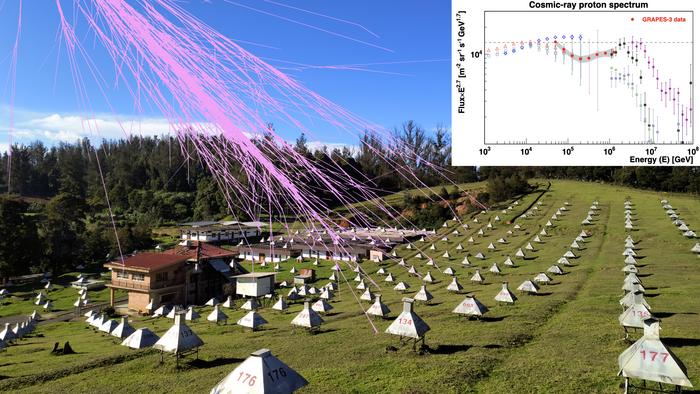The GRAPES-3 experiment in Ooty, India, operated by the Tata Institute of Fundamental Research has discovered a new feature in the cosmic-ray proton spectrum at around 166 tera-electron-volt (TeV) energy while measuring the spectrum spanning from 50 TeV to a little over one peta-electron-volt (PeV). The observed feature suggests a potential re-evaluation of our understanding of cosmic-ray sources, acceleration mechanisms, and their propagation within our Galaxy.

Credit: TIFR
The GRAPES-3 experiment in Ooty, India, operated by the Tata Institute of Fundamental Research has discovered a new feature in the cosmic-ray proton spectrum at around 166 tera-electron-volt (TeV) energy while measuring the spectrum spanning from 50 TeV to a little over one peta-electron-volt (PeV). The observed feature suggests a potential re-evaluation of our understanding of cosmic-ray sources, acceleration mechanisms, and their propagation within our Galaxy.
Cosmic rays were discovered more than a century ago. They are considered as the most energetic particles to be existed in the Universe. Our planet is constantly bombarded by them from outer space almost uniformly from all directions at a constant rate. They enter into our Earth’s atmosphere and induce a shower of particles that travel to the ground almost at the speed of light. The shower particles constitute electrons, photons, muons, protons, neutrons etc.
Cosmic rays have been observed over a remarkably wide energy range (108 to 1020 eV). The flux of cosmic ray particles decreases steeply with energy according to power-law. A kink in the cosmic-ray proton at about 3 PeV known as the knee which was discovered about seven decade ago, is believed to be the maximum energy for cosmic-ray acceleration within the Galactic sources. Single power-law description of the cosmic ray spectrum up to the knee energy has been held for a long time and explained by various models. This observation by the GRAPES-3 experiment shows a new feature above 100 TeV and below the knee.
Utilizing a combination of a dense array of plastic scintillator detectors and a large-area muon detector, the researchers at the GRAPES-3 experiment collected data with a collection area several thousand times larger than space-based detectors, allowing for a more detailed examination of cosmic rays above 100 TeV, where space-based measurements lack precision due to low statistics. About a sub-set of eight million cosmic ray shower events recorded by these detectors was analysed by Fahim Varsi and other team members to measure the cosmic-ray spectrum combined with CPU-intensive computer simulations.
The study was led by Pravata K. Mohanty, the Principal Investigator of the GRAPES-3 experiment and a faculty member at the Tata Institute of Fundamental Research, Mumbai. The findings have been published in Physical Review Letters.
Journal
Physical Review Letters
DOI
10.1103/PhysRevLett.132.051002
Article Title
Evidence of a Hardening in the Cosmic Ray Proton Spectrum at around 166 TeV Observed by the GRAPES-3 Experiment




